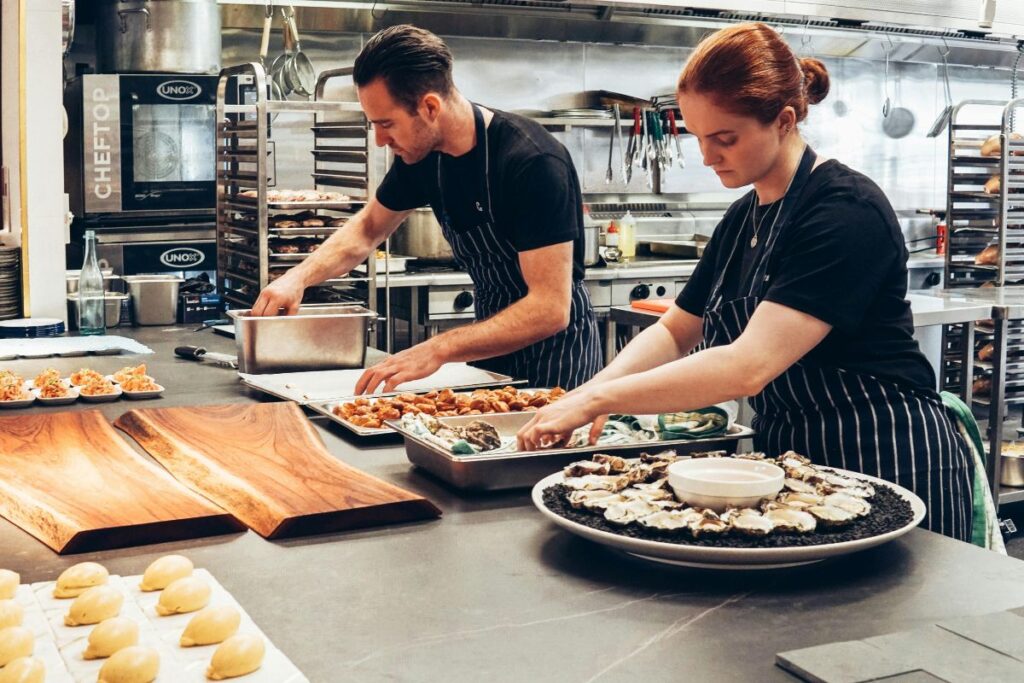Designing a commercial kitchen requires careful planning and consideration of many factors to create a functional and efficient workspace. From layout and equipment to materials and workflows, every detail matters.
Follow these tips to design the ultimate commercial kitchen for your business.
Research Regulations and Legal Requirements
The first step is understanding the legal regulations and requirements for a commercial kitchen. Consult with your local council to learn about necessary permits, health and safety rules, ventilation standards, and accessibility guidelines. This will inform decisions on layout, equipment, and design. Some key regulations to research include:

- Food safety and hygiene requirements
- Mechanical and electrical safety standards
- Guidelines for refrigeration, waste disposal, pest control, and cleaning
- Ventilation and extraction needs
- Accessibility and space allowances
Create an Efficient Layout
Kitchen layout directly impacts workflow and productivity. Separate zones for prepping, cooking, cleaning, and storage. Allow adequate space between workstations, exits, and high-traffic areas. Standard layouts include:
- Linear or assembly line format
- L-shaped or U-shaped configuration
- Islands or modular sections
Consider existing architectural elements and permanent fixtures when planning the layout. Be sure to accommodate electrical, plumbing, and ventilation needs.
Select Sturdy, Commercial-Grade Equipment
Outfit the kitchen with high-quality, commercial kitchen supplies by Tarrison designed for frequent heavy use. Key types of equipment to invest in include:


- Stainless steel countertops and sinks
- Commercial ovens, hobs, grills
- Heavy-duty refrigeration like walk-in fridges and freezers
- Food processors, mixers, and other electric appliances
- Shelving, cabinets, and storage solutions
- Hand wash basins and commercial dishwashers
Choose materials and equipment certified for commercial use that will withstand wear and tear.
Install Proper Ventilation
Proper ventilation is crucial for air quality, temperature control, and safety. Commercial kitchens have higher heat, steam, and smoke than residential kitchens. Install powerful exhaust hoods over cooking equipment to effectively remove grease, odours, heat, and contaminants.
Integrate a makeup air system to bring in fresh air and balance ventilation. Follow legal guidelines for CFM airflow ratings based on the size and equipment in your kitchen. Work with HVAC professionals to design the ideal ventilation solution.
Choose Durable, Easy-to-Clean Materials

Select flooring, walls, cabinetry, and finishes made of non-porous, commercial-grade materials. Stainless steel, metal alloys, solid surface, and tile materials are great options that withstand heavy use and are easy to sanitise.
Avoid porous materials like untreated wood, which can absorb spills, odours, and bacteria. All surfaces should be smooth, moisture-resistant, and free of grout lines or crevices that trap dirt. This facilitates thorough cleaning and promotes food safety.
Incorporate Adequate Lighting and Utilities
Proper lighting should illuminate all work areas with minimal glare and shadows. LED lights are an energy-efficient choice. Position lights over workstations, sinks, stovetops, and hazardous areas.
Ensure adequate electrical sockets around the kitchen to power appliances and equipment without overloading circuits or requiring extension cords. Include separate circuits for large equipment.
Gas and water lines must be properly sized and configured to supply cooking equipment, sinks, dishwashers, and cleaning needs.
Design for Workflow and Functionality
Keep the layout and design focused on smooth workflows and functionality. Position equipment in order of operations from delivery and storage to prep, cooking, plate-up and dishwashing. Arrange workstations for efficient movement between each zone.

Incorporate organisational features like magnetic knife strips, wall-mounted utensils, shelving for bulk ingredients, and colour-coded chopping boards. Optimise workflows to boost productivity and output.
By considering these key elements, you can create a commercial kitchen tailored to your menu, team, and operational needs. Be sure to work with knowledgeable kitchen designers and comply with all legal standards. Investing in a well-planned, fully equipped commercial kitchen helps set up your business for long-term catering success.
Images courtesy of unsplash.com and pexels.com












